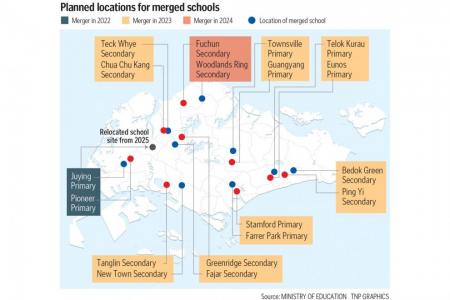Nine pairs of schools to merge amid falling births and enrolment
Falling birth numbers a big reason for the mergers, which will take place over the next three years
Another 18 primary and secondary schools are set to merge over the next three years as student enrolment continues to shrink due to Singapore's falling birthrates.
The first two schools to merge will be Juying Primary School (JYPS) and Pioneer Primary next year, and will occupy the current JYPS site.
The two schools will merge earlier than the rest to make way for the development of the Jurong Region Line MRT extension, said the Ministry of Education (MOE) at a briefing yesterday.
The merged school is expected to relocate to a new site in the Plantation District in Tengah from January 2025.
It will be the first primary school in the Tengah area.
It will not admit new Primary 1 pupils until it has moved to the new campus in Tengah. Existing pupils of the merged school will remain at the current JYPS campus, and the last batch of Primary 6 pupils will graduate in 2026.
Pioneer Primary principal Lee Wai Ling said although the school's staff were upset at the news, they understood the bigger picture.
"It's sad and difficult because we just celebrated our 25th anniversary last year, and some of the staff have been around since the school was founded, but we will do our best to help the children transition to the new environment," she said.
Another 16 schools will be merged - 14 in 2023 and another two in 2024.
BIRTH NUMBERS
Since 2010, 68 schools have been merged, including eight junior colleges in 2019. MOE said 23 schools have also opened within that time frame. The majority of these are primary schools in newer housing estates such as Punggol and Sengkang.
Falling birth numbers among Singapore residents play a large part in making these mergers necessary.
Last year, 38,705 babies were born, the lowest figure since 2010, when there were 37,967 births.
MOE said in the 1990s, resident live births averaged around 46,000 annually.
Many of the affected schools are in mature estates where there are fewer younger families.
"Nationally, there is a drop in the number of students but at the same time, there is an even more uneven distribution (of students) at a localised level," said an MOE spokesman.
The ministry said merging the schools would allow students to continue to have a fuller school experience including varied subject combinations, co-curricular activities (CCAs) and leadership opportunities.
It said schools with low enrolment numbers find it difficult to offer a good range of programmes and CCAs, and having fewer students affects the diversity of experiences and choices the school can offer.
Planning for mergers and selecting the pair of schools revolve around four key considerations, along with local supply and demand factors, said MOE.
They are: the schools' enrolment trend, their geographical proximity to each other, the suitability of the merger partners, and the receiving school's infrastructure capacity.
The names of the newly merged schools will be decided later, said MOE.
Get The New Paper on your phone with the free TNP app. Download from the Apple App Store or Google Play Store now



